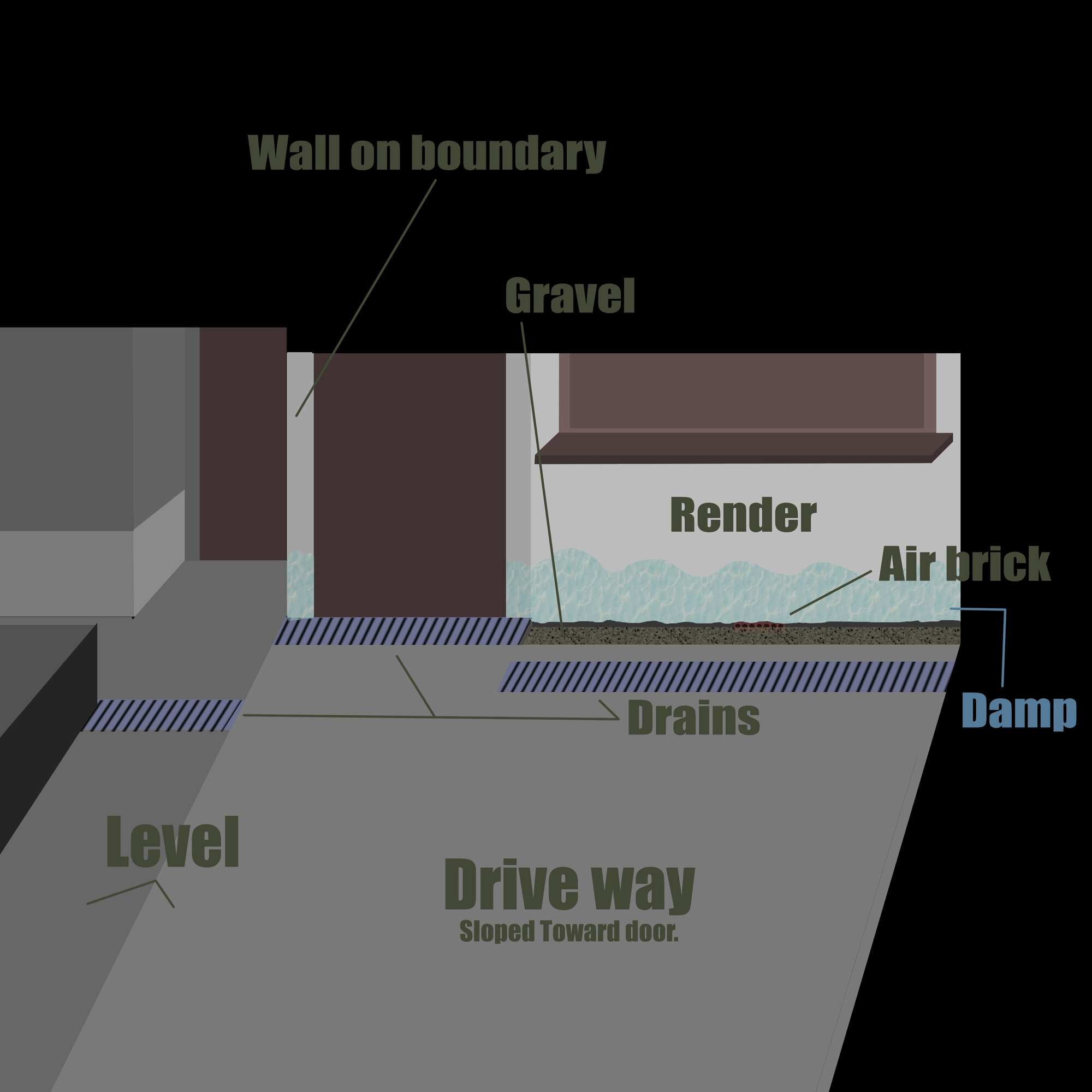- Joined
- 14 Dec 2020
- Messages
- 76
- Reaction score
- 3
- Country

Hey guys,
I'm new too the forum, been finding these tips really handy, I've been reading through alot of threads with similar issues too my problem and learnt alot but could do with some broad guidance. I've listed the problems below and I've tried to come up with solutions, just hypothetically would they work?
I'm buying a 1930 mid terrace house it has damp (rics survey) the owners have tried to fix it internally but I have not yet had the information on what works were done, but it's clear that the external render is bridging the dpc, it's a classic case of the driveway being built highier than the dpc as the original houses has a step too the front door.
The air brick is also part blocked by render, there is a drain at the front door and at the driveway under the front window, with around 40cm gravel soakway between the drive and house, the gravel is touching the airbrick and the render goes all the way too the gravel.
Solution: chop back the render at the front above the dpc. Lower gravel level and Clear airbrick. Check drains etc, add another air brick for added flow too help dry out areas.
The tricky bit..
Theres a front porch extention running along the same wall hitting the neighbours boundary, both drives are level with their front door recessed by the side of the porch extention wall which is rendered to their driveway floor with no channel or drain. I can only hope they added a new dpc level when they built the porch side wall but regardless it's still being bridged by the render.
I can imagine they wouldn't be happy with me exposing the brick dpc or cutting a channel in there drive so...
solution: check drains nearby. Check dpc level if too low Add a chemical dpc then a render plinth with a bell cast dpc (stopping splash back from rain) and blend the render in above, making the wall like the original.
I'm trying to think of practical solutions but wanted to hear from professionals or possible ideas. I dont think these will cost too much? the rest of the house is nice and dry it's just the front wall and porch.
If you guys have any tips it would be most appreciated. I dont want to add any pics because I havnt completed the purchase yet, hopefully I've described it enough.
Thanks guys.
**solid wall brick and the porch is unknown (built in the 80s).
I'm new too the forum, been finding these tips really handy, I've been reading through alot of threads with similar issues too my problem and learnt alot but could do with some broad guidance. I've listed the problems below and I've tried to come up with solutions, just hypothetically would they work?
I'm buying a 1930 mid terrace house it has damp (rics survey) the owners have tried to fix it internally but I have not yet had the information on what works were done, but it's clear that the external render is bridging the dpc, it's a classic case of the driveway being built highier than the dpc as the original houses has a step too the front door.
The air brick is also part blocked by render, there is a drain at the front door and at the driveway under the front window, with around 40cm gravel soakway between the drive and house, the gravel is touching the airbrick and the render goes all the way too the gravel.
Solution: chop back the render at the front above the dpc. Lower gravel level and Clear airbrick. Check drains etc, add another air brick for added flow too help dry out areas.
The tricky bit..
Theres a front porch extention running along the same wall hitting the neighbours boundary, both drives are level with their front door recessed by the side of the porch extention wall which is rendered to their driveway floor with no channel or drain. I can only hope they added a new dpc level when they built the porch side wall but regardless it's still being bridged by the render.
I can imagine they wouldn't be happy with me exposing the brick dpc or cutting a channel in there drive so...
solution: check drains nearby. Check dpc level if too low Add a chemical dpc then a render plinth with a bell cast dpc (stopping splash back from rain) and blend the render in above, making the wall like the original.
I'm trying to think of practical solutions but wanted to hear from professionals or possible ideas. I dont think these will cost too much? the rest of the house is nice and dry it's just the front wall and porch.
If you guys have any tips it would be most appreciated. I dont want to add any pics because I havnt completed the purchase yet, hopefully I've described it enough.
Thanks guys.
**solid wall brick and the porch is unknown (built in the 80s).
Last edited:

